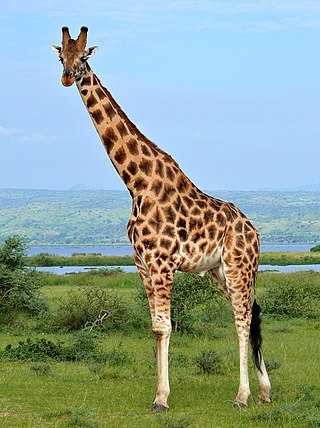Rothschild's giraffe
Population of Giraffe From Wikipedia, the free encyclopedia
The Rothschild's giraffe (Giraffa camelopardalis camelopardalis) is an ecotype of the Nubian giraffe. It is one of the most endangered distinct populations of giraffe, with 1,399 mature individuals estimated in the wild in 2018.[1] The Rothschild's giraffe is one of the most endangered giraffe subspecies with conservation efforts focused in Uganda and Kenya.[2] They are distinguished by their lighter coat color and lack of markings on their lower legs.[3] Conservation efforts of these giraffes mostly take place at the Giraffe Centre in Kenya.[4]
| Rothschild's giraffe | |
|---|---|
 | |
| A male Rothschild's giraffe at Murchison Falls National Park, Uganda | |
| Scientific classification | |
| Domain: | Eukaryota |
| Kingdom: | Animalia |
| Phylum: | Chordata |
| Class: | Mammalia |
| Order: | Artiodactyla |
| Family: | Giraffidae |
| Genus: | Giraffa |
| Species: | |
| Subspecies: | G. c. rothschildi |
| Trinomial name | |
| Giraffa camelopardalis rothschildi Lydekker, 1903 | |
 | |
| Rothschild's giraffe's range in light green | |
| Synonyms | |
|
G.c. rothschildi (Lydekker, 1903) | |
Taxonomy and evolutionary history


The IUCN currently recognizes only one species of giraffe with nine subspecies.[1] Giraffa camelopardalis rothschildi is named after the Tring Museum's founder, Walter Rothschild.[3] It is also known as the Baringo giraffe, after the Lake Baringo area of Kenya,[5] or as the Ugandan giraffe. All of those living in the wild are in protected areas in Kenya and Uganda. In 2007, Rothschild's giraffe was proposed as a separate species from other giraffe.[2] In 2016, Rothschild's giraffe was proposed as conspecific with the Nubian giraffe (elevated to full species), but that taxonomy has not been widely adopted.[6]
Characteristics
Summarize
Perspective
The Rothschild's giraffe is easily distinguishable from other subspecies. The most obvious sign is in the coloring of the coat or pelt. Whereas the reticulated giraffe has very clearly defined dark patches with bright-whitish channels between them, Rothschild's giraffe more closely resembles the Masai giraffe. However, when compared to the Masai giraffe, the Rothschild's ecotype is paler, the orange-brown patches are less jagged and sharp in shape, and the connective channel is of a creamier hue compared to that seen on the reticulated giraffe. In addition, Rothschild's giraffe displays no markings on the lower leg, giving it the impression of wearing white stockings.[3]
Another distinguishing feature of Rothschild's giraffe, although harder to spot, is the number of ossicones on the head. This is the only Giraffa phenotype to be born with five ossicones. Two of these are the larger and more obvious ones at the top of the head, which are common to all giraffes. The third ossicone can often be seen in the center of the giraffe's forehead, and the other two are behind each ear. Regarding the hybridization and habitat of the species: Rothschild’s giraffes have different genetic markers that other species usually do not, which keeps their populations safe from extinction and hybridization overlap.[7][8] They are also taller than many other populations, measuring up to 5.88 metres (19.3 feet) tall.[9][10] They can weigh up to 2,500 pounds.[11]
Males are larger than females by a few hundred pounds[11] and their two largest ossicones are usually bald from sparring. They usually tend to be darker in colour than the females, although this is not a guaranteed sexing indicator.
The meat of the Rothschild giraffe is supposedly very sweet and its bones contain a specific type of fat that traditional cultures use as medicinal components.[12]
Habitat and distribution
Isolated populations of Rothschild's giraffes live in savannahs, grasslands, and open woodlands of Uganda and Kenya. They are possibly regionally extinct from South Sudan and northeastern Democratic Republic of the Congo. 60% of the Rothschild's giraffe population is living in Uganda.[13]
Ecology and behavior
Rothschild's giraffes mate at any time of the year and have a gestation period of 14 to 16 months, typically giving birth to a single calf. They live in small herds, with males and females (and their calves) living separately, only mixing for mating.[14] The Rothschild's giraffes are tolerant of other animals around them as long as they don't feel threatened. For the most part, they are very friendly, but the males are known to engage in fights for mating. Since this species can mate all year long, those battles seem to be frequent.[15]
Threats and conservation efforts
Summarize
Perspective
As of 2018, Rothschild's giraffe is classified as near threatened. Very few locations are left where Rothschild's giraffe can be seen in the wild, with notable spots being Lake Nakuru National Park in Kenya[16] and Murchison Falls National Park[17] in northern Uganda. Their predators are hyenas, lions, crocodiles, and leopards.[11]
Two dwarf giraffes standing only 9.5 feet (2.9 m) tall have been spotted in Murchison Falls National Park. Scientists speculate their dwarfism may have been caused by inbreeding due to species decline.[18]

Three Rothschild's giraffes were electrocuted by low-hanging power lines in Soysambu conservancy in Nakuru, Kenya.[19]
Various captive breeding programmes are in place – most notably at the Giraffe Centre in Nairobi, Kenya – which aim to expand the gene pool in the wild population of Rothschild's giraffe. As of January 2011[update], more than 450 are kept in ISIS (international species information system) registered zoos (which does not include the Nairobi Giraffe Centre), making both it and the reticulated giraffe the most commonly kept phenotypes of Giraffa.[4] Breeding these giraffes are one of the large attempts to protect this species. Giraffe Centre, a conservation center dedicated to protecting and expanding this giraffe population. They release these giraffes into the wild when they are approximately two to three years old. They are only released into the wild when they are thought to be independent enough to survive on their own. This center has released over 40 giraffes into the wild.[20]
References
External links
Wikiwand - on
Seamless Wikipedia browsing. On steroids.

